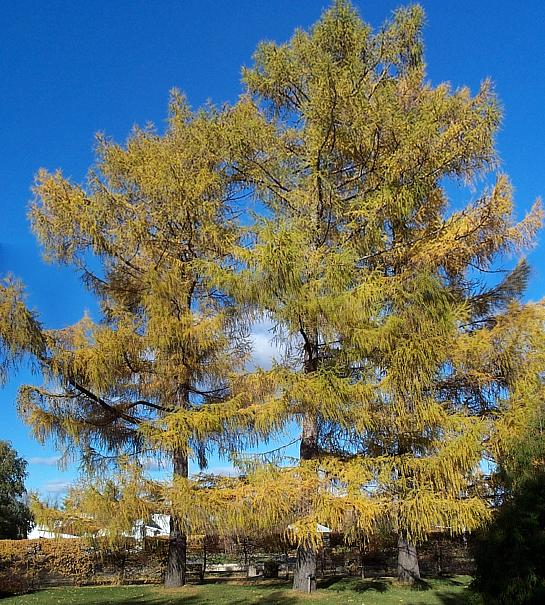- Siberian Larch
Taxobox
name = Siberian Larch
status = LR/lc | status_system = IUCN2.3

image_width = 250px
image_caption = Siberian Larch in Montreal Botanic Gardens
regnum =Plant ae
divisio =Pinophyta
classis = Pinopsida
ordo =Pinales
familia =Pinaceae
genus = "Larix"
species = "L. sibirica"
binomial = "Larix sibirica"
binomial_authority = Ledeb.The Siberian Larch or Russian Larch ("Larix sibirica"; syn. "L. russica") is a frost-hardy tree native to western
Russia , from close to the Finnish border east to theYenisei valley in centralSiberia , where it hybridises with theDahurian Larch "L. gmelinii" of eastern Siberia; the hybrid is known as "Larix × czekanowskii ".It is a medium-size to large
deciduous coniferoustree reaching 20-40 m tall, with a trunk up to 1 m diameter. The crown is conic when young, becoming broad with age; the main branches are level to upswept, with the side branches often pendulous. The shoots are dimorphic, with growth divided into long shoots (typically 10-50 cm long) and bearing severalbud s, and short shoots only 1-2 mm long with only a single bud. It is most easily distinguished from the closely relatedEuropean Larch by the shoots being downy (hairless in European Larch). The leaves are needle-like, light green, 2-4 cm long, and turn bright yellow before they fall in the autumn, leaving the pale yellow-buff shoots bare until the next spring.The male and female cones are borne separately on the same tree; pollination is in early spring. The male cones are solitary, yellow, globose to oblong, 4-8 mm diameter, and produce wingless pollen. The mature female cones are erect, ovoid-conic, 2-4 cm long, with 30-70 erect or slightly incurved (not reflexed) and downy seed scales; they are green variably flushed red when immature, turning brown and opening to release the winged
seed s when mature, 4-6 months after pollination. The old cones commonly remain on the tree for many years, turning dull grey-black. The minimum seed-bearing age is 10-15 years.Uses
Because of its rot resistance, larch wood is especially valuable for posts, poles, railroad tie sleepers, and mine props.
It is also used in many
velodrome s around the world as the track surface including theManchester Velodrome cite web | title = Manchester Velodrome Track to be Replaced | work = Manchester Track News | url = http://www.britishcycling.org.uk/web/site/BC/tra/News2006/20061101_manchester_refurb.asp | publisher=britishcycling.org.uk | date =2007-11-01 | accessdate=2008-02-28] and the VelodromeKrylatskoye inMoscow . [cite web | title = UCI World Cup Classics | work = UCI | url = http://www.uci.ch/imgArchive/Track/World%20Cup/2006-2007/info%20g%C3%A9n%C3%A9%20Moscou%20anglais.pdf | accessdate=2008-02-28]It is grown in
Canada and the northernUnited States to a limited extent, first cultivated there in1806 .It is faster-growing than many other coniferous trees in cold regions, but requires full sunlight. When grown in
plantation s it should be kept widely spaced, and intensive thinning is required.Notes
References
*
External links
* [http://www.pinetum.org/cones/mpfcones.htm Siberian Larch cones photographs]
Wikimedia Foundation. 2010.
